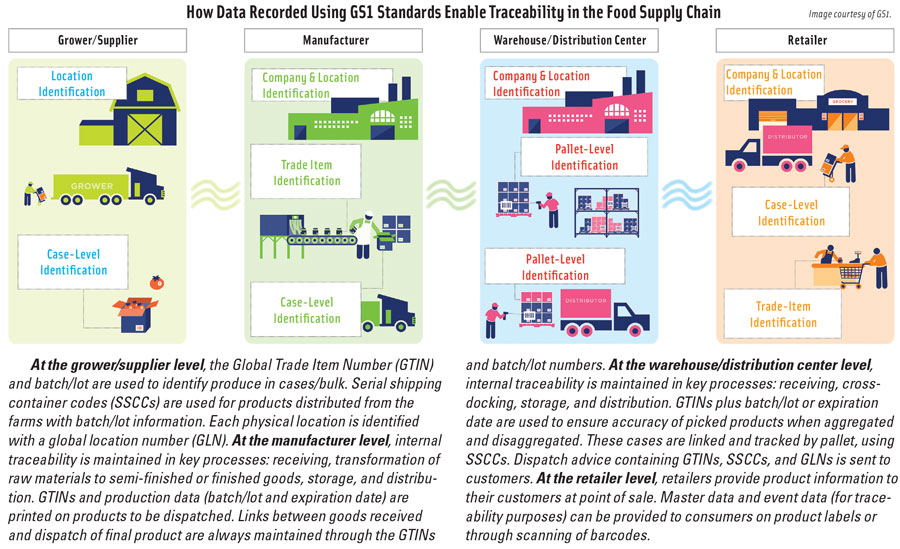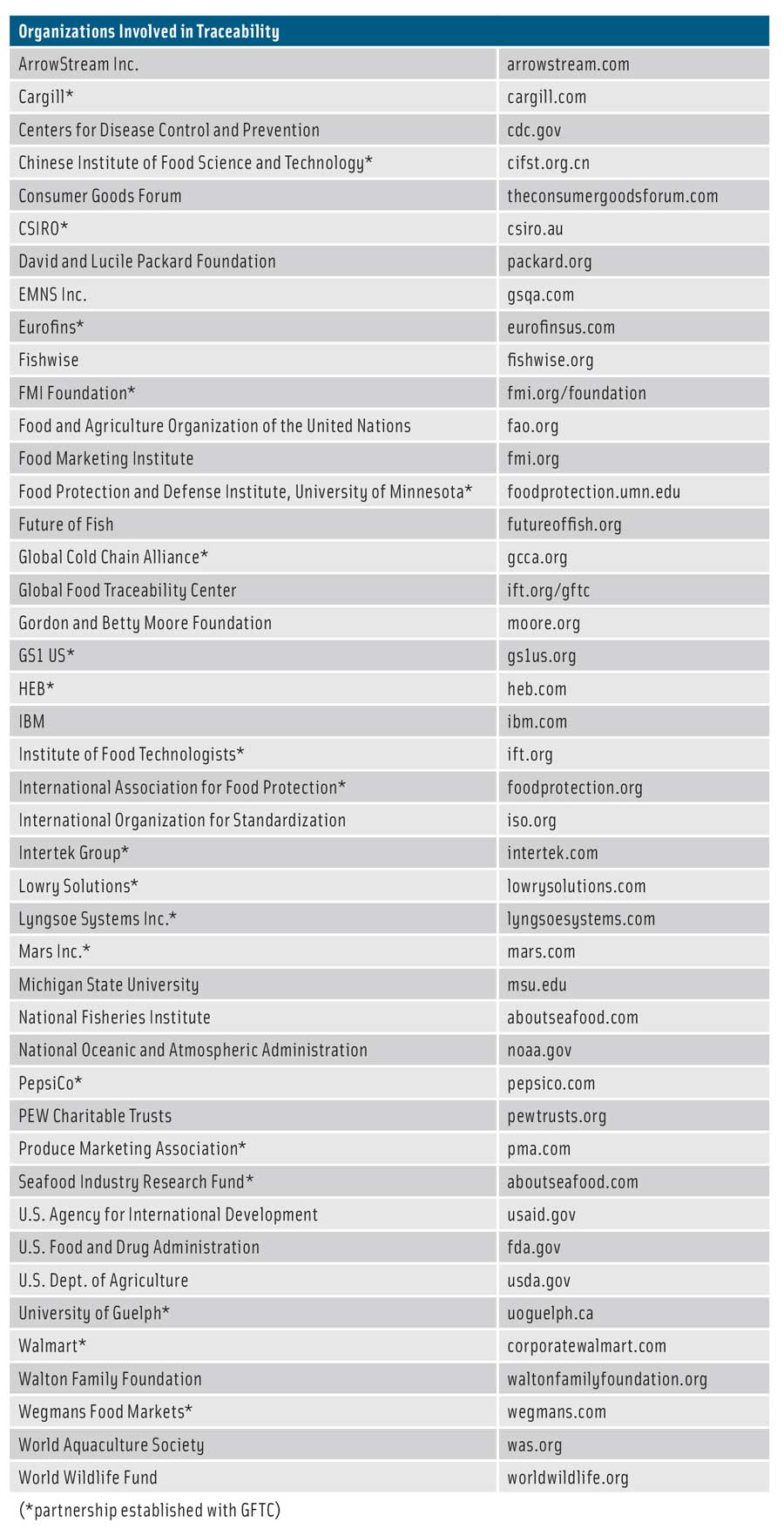Tracking Traceability
FOOD SAFETY AND QUALITY
The Institute of Food Technologists (IFT) has addressed food traceability for more than a decade. In 2008 the U.S. Food and Drug Administration (FDA) commissioned IFT to evaluate tracing systems and provide recommendations for a product-tracing system. In 2009 IFT provided its report, “Traceability (Product Tracing) in Food Systems: An IFT Report Submitted to the FDA,” which consisted of two documents, “Technical Aspects and Recommendations” and “Cost Considerations and Implications,” both of which were published in the January 2010 issue of IFT’s Comprehensive Reviews in Food Science and Food Safety (CRFSFS). Also, in March 2010 IFT submitted comments in response to a joint FDA and U.S. Dept. of Agriculture (USDA) notice regarding product tracing in food systems and recommended guidelines for establishing a comprehensive system to track the movement of food products from farm to point of sale or service. And in 2011 IFT and GS1 US began a series of webcasts and workshops on traceability.
In September 2013 IFT, with the help of 17 sponsoring organizations, established its Global Food Traceability Center (GFTC) to help the global food industry trace products through the supply chain to improve food safety, diminish risk, avert devastating health consequences, and avoid economic loss to the food system. It is a science-based, not-for-profit public-private partnership that brings together key stakeholders in the food system to collaborate on traceability solutions and serves as an authoritative source of information about food traceability. IFT’s Tejas Bhatt, vice-president, Science and Policy Initiatives, and director of the GFTC, provided insight on what has been accomplished and what’s ahead.
GFTC Projects
Bhatt said that several projects have already been completed and reports have either been made available on the IFT website or will be available shortly:
• Enhancing Global Seafood Traceability. This project, supported by a grant from the Gordon and Betty Moore Foundation, focused on developing an interoperable framework for traceability. With input from 30 subject matter experts over a span of two years, the GFTC developed guiding principles on how stakeholders can enable data sharing more effectively and efficiently, using existing investments in traceability while planning for technology innovations in the future. This data-sharing framework, Bhatt said, is aligned with most other initiatives that are evaluating similar issues, including the United States Agency for International Development (USAID) Oceans and Fisheries Partnership and the Consumer Goods Forum Interoperability Initiative. A status report on the GFTC project, titled “Project to Develop an Interoperable Seafood Traceability Technology Architecture: Issues Brief,” was published in the March 2016 issue of CRFSFS. Bhatt expects a final report on the project to be published on the GFTC website soon.
• Developing a Seafood Catch Documentation and Traceability Architecture for the ASEAN Region. Supported by a grant from the USAID and conducted in collaboration with Future of Fish, this project has the goal of developing a financially stable catch documentation and traceability system to combat illegal, unreported, and unregulated fishing and seafood fraud in Southeast Asia and to enhance public and private partnerships to conserve biodiversity and promote sustainable fisheries management. The project involves ensuring alignment with global standards, monitoring and evaluating pilot demonstrations of reference implementations of the architecture, and building an industry coalition to help support and scale the rollout of the architecture. The project is expected to be completed by August 2017.
• Conducting Traceability Education and Training Workshops in Nine Caribbean Countries. In this project, supported by a grant from the Inter-American Institute for Cooperation on Agriculture (IICA), the GFTC conducted workshops during the second half of 2016 in Barbados, Belize, Grenada, Guyana, Jamaica, St. Kitts, St. Lucia, St. Vincent, and Suriname. About 300 small to mid-size businesses learned the best practices of traceability, Bhatt said, including how to leverage traceability to reduce risks in the supply chain, gain access to export and import markets, and reduce costs through operational efficiencies.
• Developing Seafood Traceability Financial and Consumer Preference Tools. These tools are designed to reduce waste, enhance consumer trust, and increase business efficiencies. The financial tool is designed to help organizations in the seafood industry assess the costs and benefits associated with implementing traceability. The consumer preference tool provides an easy-to-use interface to analyze the data from a survey of nearly 2,500 consumers in the United States, Canada, Germany, China, and the Netherlands to find out their preferences and price sensitivities to different types of seafood products.
• Referencing Best Practices in Food Traceability. The GFTC assessed food traceability best practices in selected industry sectors and created a reference document based on principles of critical tracking events and key data elements. The reference document, titled “A Guidance Document on the Best Practices in Food Traceability,” published in the September 2014 issue of CRFSFS, serves as a guide for government regulatory authorities and others to foster the use of uniform data gathering and recordkeeping requirements.
• Comparing Global Food Traceability Regulations. The GFTC prepared a report comparing food traceability regulations around the world. The report, titled “Comparison of Global Food Traceability Regulations and Requirements,” was published in the September 2014 issue of CRFSFS.
Bhatt also described three ongoing projects funded by the Gordon and Betty Moore Foundation:
• Developing a Food Traceability Plan Builder Tool. This tool, being developed in collaboration with FishWise, will take stakeholders through a series of interactive questions to help them identify gaps in their current traceability capabilities as well as assess their level of risk in the supply chain based on their traceability practices.
• Establishing a Global Dialogue on Seafood Traceability. This project, being conducted with the World Wildlife Fund, will align data requirements and data sharing across the global supply chain. It will cover both wild-caught fish and farmed fish, including issues related to feed traceability in aquaculture.
• Educating and Training Traceability Stakeholders. In collaboration with Future of Fish, World Wildlife Fund, and FishWise, this project addresses how to implement better traceability globally.
Organizations Involved in Traceability
Many types of organizations are involved in traceability, Bhatt said. There are standards-setting organizations like GS1, FAO, and ISO; governmental organizations like FDA, USDA, and the National Oceanic and Atmospheric Administration (NOAA); nongovernmental organizations like Australia’s CSIRO, the Chinese Institute of Food Science and Technology, and the International Association for Food Protection; environmental organizations like the World Wildlife Fund, Future of Fish, and FishWise; private-sector organizations like Cargill, Pepsi, and Walmart; trade associations like the Food Marketing Institute, National Fisheries Institute, Produce Marketing Association, and Global Cold Chain Alliance; universities such as the University of Minnesota’s Food Protection and Defense Institute, University of Guelph, and Michigan State University; technology solution providers like IBM, Lowry Solutions, Lyngsoe Systems Inc., and EMNS Inc. (GSQA); and foundations such as the Gordon and Betty Moore Foundation, Packard Foundation, Walton Foundation, and Pew Charitable Trusts.
The Food Safety Modernization Act (FSMA) expanded the authority of the FDA to establish a product tracing system to quickly track and trace foods as they move through the supply chain. Bhatt said that the FDA is expected to release new rules under section 204 of the FSMA on enhanced traceability requirements for high-risk foods. In January 2013 the USDA issued its final rule regarding animal disease traceability, establishing general regulations for improving the traceability of U.S. livestock moving interstate. The U.S. Centers for Disease Control and Prevention does not address food traceability directly but does work with the FDA and the USDA on foodborne illness outbreak investigations. NOAA recently released final rules on its seafood traceability program, requiring stringent data reporting from importers of certain species of seafood deemed high risk for illegal fishing.
Challenges and Solutions Ahead
There are several challenges and solutions ahead for traceability: Consumers are demanding more and more data from the industry, Bhatt said, and the Grocery Manufacturers Association is trying to address this issue through its SmartLabel Transparency Initiative. Many countries are updating their regulatory frameworks to require more robust traceability from the industry. Business drivers include food safety (public health outbreaks and recalls management), food defense (bioterrorism and disgruntled employees), food fraud (counterfeiting and theft), and sustainability (illegal fishing and environmental impact).
Traceability technology is growing exponentially, Bhatt said. Through the GFTC’s research and outreach efforts over the last decade or so, he has become aware of hundreds of different technology solution providers. More recently, technology solution providers that were providing traceability in the pharmaceutical sector have started to bring their serialization technology to the food sector. Many novel technology innovations are being commercialized, he added, including the use of Internet of Things and block-chain to enable trust and transparency in the food sector. Some technologies provide internal traceability within the four walls of a facility while others provide external traceability creating linkages between suppliers and customers. A few even provide both capabilities. Innovations such as using synthetic deoxyribonucleic acid (DNA) on packaging to trace tampering or using handheld DNA species identification to mitigate food fraud are also being developed.
 Neil H. Mermelstein, IFT Fellow,
Neil H. Mermelstein, IFT Fellow,
Editor Emeritus of Food Technology
[email protected]






